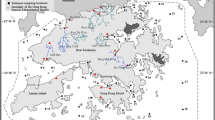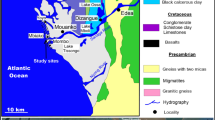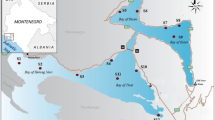Abstract
Based on ten heavy metals collected twice annually at 59 sites from 1998 to 2004, enrichment factors (EFs), principal component analysis (PCA) and multivariate linear regression of absolute principal component scores (MLR-APCS) were used in identification and source apportionment of the anthropogenic heavy metals in marine sediment. EFs with Fe as a normalizer and local background as reference values was properly tested and suitable in Hong Kong, and Zn, Ni, Pb, Cu, Cd, Hg and Cr mainly originated from anthropogenic sources, while Al, Mn and Fe were derived from rocks weathering. Rotated PCA and GIS mapping further identified two types of anthropogenic sources and their impacted regions: (1) electronic industrial pollution, riparian runoff and vehicle exhaust impacted the entire Victoria Harbour, inner Tolo Harbour, Eastern Buffer, inner Deep Bay and Cheung Chau; and (2) discharges from textile factories and paint, influenced Tsuen Wan Bay and Kwun Tong typhoon shelter and Rambler Channel. In addition, MLR-APCS was successfully introduced to quantitatively determine the source contributions with uncertainties almost less than 8%: the first anthropogenic sources were responsible for 50.0, 45.1, 86.6, 78.9 and 87.5% of the Zn, Pb, Cu, Cd and Hg, respectively, whereas 49.9% of the Ni and 58.4% of the Cr came from the second anthropogenic sources.







Similar content being viewed by others
References
American Public Health Association (1995) Standard methods for the examination of water and wastewater, 19th edn. Washington, DC
American Society for Testing and Materials (2001) American society of testing and materials standards. New York
Astel A, Biziuk M, Przyjazny A, Namiesnik J (2006) Chemometrics in monitoring spatial and temporal variation in drinking water quality. Water Res 8:1706–1716
Blaser P, Zimmermann S, Luster J, Shotyk W (2000) Critical examination of trace element enrichments and depletions in soils: As, Cr, Cu, Ni, Pb, and Zn in Swiss forest soils. Sci Total Environ 249:257–280
Box GEP, Cox DR (1964) An analysis of transformations. J R Stat Soc A Sta Ser B 26:211–252
Brūmelis G, Lapiņa L, Nikodemus O, Tabors G (2000) Use of an artificial model of monitoring data to aid interpretation of principal component analysis. Environ Modell Softw 15:755–763
Cobelo-García A, Prego R (2003) Heavy metal sedimentary record in a Galician Ria (NW Spain): background values and recent contamination. Mar Pollut Bull 46:1253–1262
Covelli S, Fontolan G (1997) Application of a normalization procedure in determining regional geochemical baselines. Environ Geol 30(1–2):34–45
El Nemr A, Khaled A, El Sikaily A (2006) Distribution and statistical analysis of leachable and total heavy metals in the sediments of the Suez Gulf. Environ Monit Assess 118:89–112
Fharnham IM, Singh AK, Stetzenbach KJ, Lohannesson KH (2002) Treatment of nondetects in multivariate analysis of groundwater geochemistry data. Chemometr Intell Lab 60:265–281
Facchinelli A, Sacchi E, Mallen L (2001) Multivariate statistical and GIS-based approach to identify heavy metal sources in soils. Environ Pollut 114:313–324
González-Maćias C, Schifter I, Lluch-Cota DB, Mendez-Rodriguez L, Hernandez-Vazquez S, (2006) Distribution, enrichment and accumulation of heavy metals in coastal sediments of Salina Cruz Bay, Mexico. Environ Monit Assess 118:211–230
Glasby GP, Szefer P, Geldon J, Warzocha J (2004) Heavy-metal pollution of sediments from Szczecin Lagoon and the Gdansk Basin, Poland. Sci Total Environ 330:249–269
Han YM, Du PX, Cao JJ, Posmentier ES (2006) Multivariate analysis of heavy metal contamination in urban dusts of Xi’an, Central China. Sci Total Environ 355:176–186
Hong Kong Environmental Protection Department (2005) Marine water quality in Hong Kong, Hong Kong Government Printer, Hong Kong
Hopke PK (2003) Recent developments in receptor modeling. J Chemometr 17:255–265
Johnson RA, Wichern DW (2002) Applied multivariate statistical analysis, 5th edn. Prentice-Hall, NJ
Lau MM, Rootham RC, Bradley GC (1993) A strategy for the management of contaminated dredged sediment in Hong Kong. J Environ Manage 38:99–114
Liu WX, Li XD, Shen ZG, Wang DC, Wai OWH, Li YS (2003) Multivariate statistical study of heavy metal enrichment in sediments of the Pearl River Estuary. Environ Pollut 121:377–388
Owen RB, Sandhu N (2000) Heavy metal accumulation and anthropogenic impacts on Tolo Harbour, Hong Kong. Mar Pollut Bull 40:174–180
Pekey H, Karakaş D, Bakoğlu M (2004) Source apportionment of trace metals in surface waters of a polluted stream using multivariate statistical analyses. Mar Pollut Bull 49:809–818
Peré-Trepat E, Olivella L, Ginebreda A, Caixach J, Tauler R (2006) Chemometrics modelling of organic contaminants in fish and sediment river samples. Sci Total Environ 371:223–237
Reimann C, de Caritat P (2000) Intrinsic flaws of element enrichment factors (EFs) in environmental geochemistry. Environ Sci Technol 34:5084–5091
Reimann C, de Caritat P (2005) Distinguishing between natural and anthropogenic sources for elements in the environment: regional geochemical surveys versus enrichment factors. Sci Total Environ 337:91–107
Qu W, Kelderman P (2001) Heavy metal contents in the Delft canal sediments and suspended solids of the river Rhine: multivariate analysis for source tracing. Chemosphere 45:919–25
Shine JP, Ika RV, Ford TE (1995) Multivariate statistical examination of spatial and temporal patterns of heavy-metal contamination in New-Bedford Harbor marine-sediments. Environ Sci Technol 29:1781–1788
Simeonov V, Stratis JA, Samara C, Zachariadis G, Voutsa D, Anthemidis A, Sofoniou M, Kouimtzis T (2003) Assessment of the surface water quality in Northern Greece. Water Res 37:4119–4124
Sin SN, Chua H, Lo W, Ng LM (2001) Assessment of heavy metal cautions in sediments of Shing Mun River, Hong Kong. Environ Int 26:297–301
Song Y, Xie SD, Zhang YH, Zeng LM, Salmon LG, Zheng M (2006) Source apportionment of PM25 in Beijing using principal component analysis/absolute principal component scores and UNMIX. Sci Total Environ DOI 10.1016/j.scitotenv. 2006.08.041
Tam NFY, Wong YS (2000) Spatial variation of heavy metals in surface sediments of Hong Kong mangrove swamps. Environ Pollut 110:195–205
Tanner PA, Leong LS, Pan SM (2000) Contamination of heavy metals in marine sediment cores from Victoria Harbour, Hong Kong. Mar Pollut Bull 40:769–779
Thurston GD, Spengler JD (1985) A quantitative assessment of source contributions to inhalable particulate matter pollution in Metropolitan Boston. Atmos Environ 19:9–25
Wang XS, Qin Y (2006) Use of multivariate statistical analysis to determine the relationship between the magnetic properties of urban topsoil and its metal, S, and Br content. Environ Geol 51:509–516
Watson JG, Zhu T, Chow JC, Engelbrecht J, Fujita EM, Wilson WE (2002) Receptor modeling application framework for particle source apportionment. Chemosphere 49:1093–1136
Wedepohl KH (1995) The composition of the continental crust. Geochim Cosmochim Acta 59:1217–1232
Wong CKC, Yeung HY, Cheung RYH, Yung KKL, Wong MH (2000) Ecotoxicological assessment of persistent organic and heavy metal contamination in Hong Kong coastal sediment. Arch Environ Contam Toxiol 38:486–493
Zhang CS (2006) Using multivariate analyses and GIS to identify pollutants and their spatial patterns in urban soils in Galway, Ireland. Environ Pollut 142:501–511
Zhou F, Liu Y, Guo HC (2006) Application of multivariate statistical methods to the water quality assessment of the watercourses in the Northwestern New Territories, Hong Kong. Environ Monit Assess DOI 10.1007/s10661-006-9497-x
Zoller WH, Gladney ES, Duce RA (1974) Atmospheric concentrations and sources of trace metals at the South Pole. Science 183:199–201
Acknowledgments
We would like to thank Prof. Shu Tao and Mr. Yu Yang for their valuable suggestions. This paper was supported by the China Scholarship programs (2006100766) for Feng Zhou and the National Basic Research Program (No.2005CB724205). The opinions in this paper are those of the authors and do not reflect the views or policies of HKEPD.
Author information
Authors and Affiliations
Corresponding author
Rights and permissions
About this article
Cite this article
Zhou, F., Guo, H. & Liu, L. Quantitative identification and source apportionment of anthropogenic heavy metals in marine sediment of Hong Kong. Environ Geol 53, 295–305 (2007). https://doi.org/10.1007/s00254-007-0644-7
Received:
Accepted:
Published:
Issue Date:
DOI: https://doi.org/10.1007/s00254-007-0644-7




